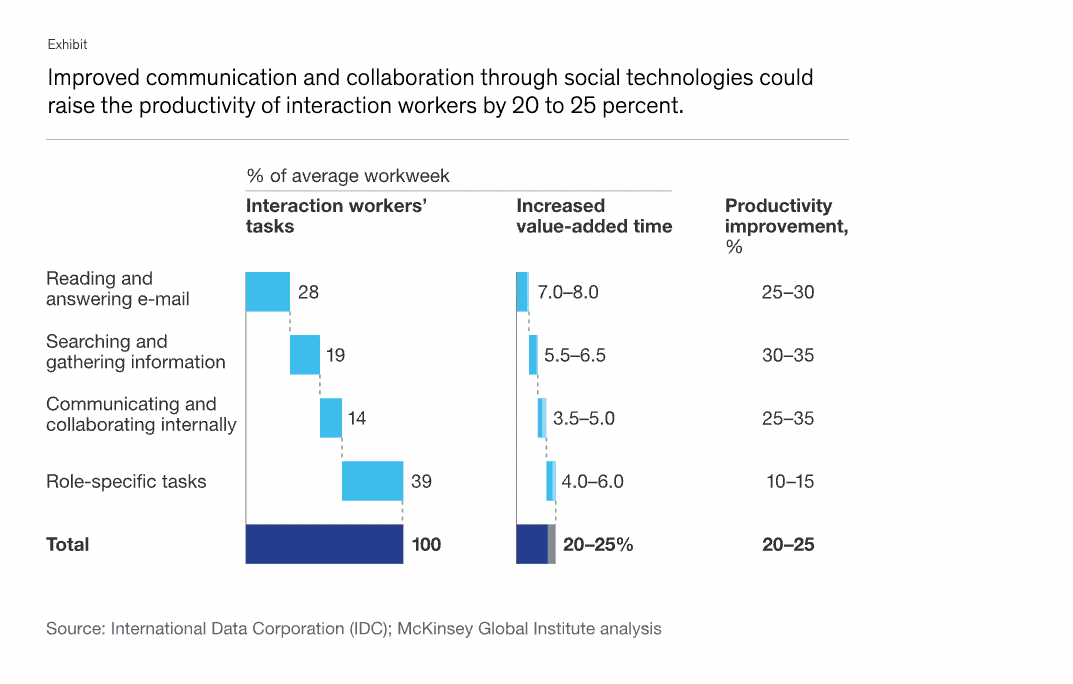March 17 2024

Promoting employee engagement and team collaboration can sometimes be easier said than done – especially when more and more employees work remotely. To provide a hub for communication, collaboration, and engagement, many companies use an enterprise social network (ESN).
However, some organizations find it challenging to implement ESNs. This is often due to low engagement, a lack of clear purpose for the platform, or difficulty integrating the tool into daily workflows.
In this comprehensive guide to ESNs, we’ll cover everything you need to know about these unique platforms – including best practices for maximizing their effectiveness.

What is an enterprise social network?
Enterprise social networks are like a company social media platform where employees can communicate and collaborate via discussion threads, social feeds, and post interactions. These collaboration tools encourage social and informal communication, help with task management, and improve employee morale.
ESNs have been around in some form or another for a surprisingly long time. Yammer (now owned by Microsoft) was one of the first solutions to hit the market in 2008, and Facebook launched its Workplace offering in 2016. However, the space is still evolving and innovating.
Modern ESN platforms offer several advantages compared to their older counterparts. For example, Workvivo is optimized for maximum engagement and has plenty of real-time communication tools and advanced analytics for powerful insights.
How are enterprise social networks different from social media?
Most people are familiar with external-facing social networking platforms, such as Facebook, Twitter, Instagram, and LinkedIn. On these social media networks, people connect or follow each other and communicate with others across the world.
ESNs, on the other hand, allow you to create a private and secure social platform for your company that focuses on workplace communication and collaboration.
Modern ESNs, such as Workvivo, also tend to offer a lot of tools and features you won’t get with a public social networking platform. This makes them a much better choice for efficient internal communication.
Social Intranets
Why do organizations need enterprise social networks?

Studies show that ESNs have a significant impact on employee satisfaction and productivity by reducing obstructions and challenges in the workplace.
Organizations that effectively introduce an enterprise social network can drive more efficient work, better employee engagement, and improved task and project management. ESNs also support employee engagement, a sense of community, and a positive culture, allowing employees to socialize with each other or give kudos for a job well done.
While some traditional company intranets have a communication component, they don’t offer the same benefits as a true social intranet.
An ESN offers several distinct advantages compared to traditional intranet platforms and other communication channels, such as email and SMS. It offers a centralized hub for all internal communications and a digital workplace where employees can collaborate, communicate, and engage on a more personal level.
What Are the Major Benefits of Enterprise Social Networking?

ESNs offer a range of functionalities and features that make them highly effective communication platforms. Some of the top benefits that companies can expect when they adopt a modern ESN like Workvivo include:
Nurturing and amplifying corporate culture
Corporate culture is such an essential aspect of an organization’s success. Developing and maintaining company culture can be easier for smaller companies, especially if all employees work in the same office. But, it can be a real challenge for larger organizations with distributed teams across multiple locations and time zones.
However, ESNs can maintain a strong culture across an entire company or help to evolve a new one. ESNs break down barriers across locations, divisions, teams, and hierarchies in ways that other communication channels simply can’t.
An ESN reflects what the entire workforce is doing and thinking rather than giving you a sanitized, corporate, and inauthentic view of your organizational culture. They show the natural ways employees live company values and allow business leaders to listen to team members and have informal conversations.
Driving transparency and employee engagement
An ESN also establishes an unparalleled level of transparency across all employees, which can drive a sense of being part of something bigger, underpinning employee engagement across the entire organization.
Imagine being a team member of a big company with thousands of employees like VMware or Salesforce. An ESN lets your manager share some great work you did, which gets a comment like “Great job, really impressive work” from your CEO.
The kind of transparency afforded by an internal social network can change employees’ perceptions about the organization they work for and its leadership. An employee feels less like a little cog in a big machine and more like a valued team member.
Similarly, an ESN can help employees feel listened to and trusted, which, in turn, improves communication.
For example, leadership can use an ESN to ask important questions that lead to debates and inputs into future company strategy. Employees can contribute ideas that can lead to real change or key initiatives.
Using polls and other feedback mechanisms via an ESN means employees can influence everything from a full-on organizational strategic pivot to what foods should be included on the menu at the annual company off-site weekend.
A solid framework for communication

ESNs provide a highly effective platform for open and diverse communication – which is vital considering the impact workplace connectivity has on productivity.
Rather than blitzing inboxes with hard-to-follow email threads, an ESN allows employees to have concise conversations displayed clearly on an activity feed. Plus, employees can create groups related to specific topics or projects to make sure everyone involved is included in the discussion.
For example, the marketing team might create a group to discuss the content marketing calendar. However, the accounting team doesn’t need to be part of that group and wouldn’t receive updates about it.
An ESN also helps support internal communications, providing important news and updates from leaders.
Whether for business or social communication, an Enterprise Social Network will provide a solid, everything-in-one-place platform for communication.
Sharing Knowledge Company-Wide
ESNs are an excellent tool for knowledge sharing and learning, particularly in large organizations with multiple locations.
For example, say your EMEA sales team develops a new outbound lead generation process that generates 50% more leads. Using the ESN, they can easily share the details of that process with other sales teams in different countries.
Team members from other departments can also ask follow-up questions about the process, and the answers will be available for all to see at any time.
Knowledge sharing can be especially helpful for new employees who are trying to settle into their roles. With an ESN, employees can crowdsource answers from anyone in the company, regardless of their department or location.
Some ESNs like Workvivo offer a cloud-based knowledge repository, so employees can search for answers within the company knowledge base.
Helping remote workers feel like part of the team
A survey by Expert Market finds that 93% of businesses plan to keep employees hybrid or remote. Enterprise social networking is naturally a great fit for remote workplace communication, allowing remote employees to:
- Easily ask questions and communicate
- Share documents and collaborate on projects
- Understand and support the company culture
- Feel like a genuine, valued part of the team
- Receive recognition for their achievements and contributions.
With so many employees now working remotely at least part of the time, ESNs have never been so powerful.
Tapping into expertise

Knowledge sharing can be key for new employees to settle into their role or tap the expertise of specialists right across the world.
Take the example of a new sales rep speaking with a prospect about a product who gets asked a question she hasn’t encountered before.
With an Enterprise Social Network, our new sales rep can easily put the question out there and crowdsource the answer from anyone in the company, regardless of whether they are based on the same floor as her or in a completely different country.
Alternatively, an ESN may contain a cloud-based knowledge repository, allowing the rep to search for the answer within a knowledge base.
Similarly, an employee might need to source a person who can speak Latvian or an expert on the marine industry. These might sound like obscure examples, but they are the types of questions that come up daily in any medium-sized or large organization.
Sourcing a colleague you’ve never met before is tricky with email alone. Using an ESN to crowdsource answers to questions is quick and easy. You can tap into the collective knowledge of your organization and get answers to even the most obscure questions quickly.
Driving efficiency and growth
Many of the benefits mentioned above relate to culture and communication, but an ESN can also drive efficiency by improving key processes within your organization. More focused collaboration, knowledge sharing, and improved employee onboarding can significantly increase efficiency and productivity.
For example, take our sales team again. Let’s say they need to respond to an opportunity ASAP. An ESN can help them immediately assemble a team and find a specialist who can impress the client.
They can put together a sales deck quickly, access best-practice templates, and then coordinate follow-up activities via a special group set up for the opportunity.
Top 10 features of an enterprise social network:

A high-quality ESN will offer a wide range of features designed to enhance collaboration and promote employee engagement. Here are 10 of the top features you can look forward to with an advanced ESN like Workvivo:
1. Access for everybody
An ESN should facilitate access for all your employees. Otherwise, you create a digital divide. For example, a true ESN should allow access to your frontline, desk-less employees, like machine operatives, nurses or chefs, even if they don’t have corporate email identities.
2. An activity feed
Your ESN should have a familiar activity feed allowing employees to post content with images, videos, documents and more. The activity feed is often the heart of the ESN, where employees can be kept up to speed on the latest updates, events, activities and news.
3. Ability to interact and contribute
ESNs should allow employees to like, comment and share content, as well as useful features like #hashtags and @mentions to get the best from the tools.
4. Employee directory and profiles
An ESN should provide an employee directory so that employees can find out about their co-workers, reach contact details, locate experts and more.
5. Follows, communities and groups
Employees should be able to follow each other and topics and be members of different communities and groups. These ‘follows’ and memberships usually define what goes into the activity feed.
6. Integration with other platforms
Ideally, your enterprise social network should have out-of-the-box integrations with other communication apps and content management systems. For example, Workvivo has integration capabilities with SharePoint, Slack, Zoom, and Microsoft Teams.
7. Easy collaboration
An ESN should allow employees to collaborate with colleagues across locations and departments using groups or workspaces. In Workvivo, this feature is called Spaces, and it can help you share targeted updates, questions, and shout-outs.
8. Celebrate success and recognize outstanding performers
Features like shout-outs, awards and badges can give an employee or team well-deserved public recognition and help them feel more engaged with the organization.
9. Supporting leadership communications
An ESN should allow your leadership team to communicate one-on-one and share information with all employees through updates, announcements, blogs, and even town halls.
10. Employee feedback and pulse checks
A good ESN makes it simple to gather employee feedback. Workvivo, for example, has quick and easy surveys that enable frequent pulse checks to garner valuable feedback from employees.
Best practices to maximize the effectiveness of an enterprise social network
Like any tool, how your company uses its ESN is going to have as big of an impact on the employee experience as the specific tool you use. If you would like to maximize the benefits that a high-quality ESN offers, here are three best practices to employ.
Clearly define objectives
It’s important to set clear and measurable objectives for your ESN so that you can analyze how the platform is impacting key business goals. With Workvivo’s Workplace Insights feature, you can easily track important metrics like content engagement and employee sentiment to see how the ESN meets objectives.
Improving internal communication, enhancing collaboration, and boosting employee engagement are a few examples of the types of objectives you can set.
Gain executive buy-in and leadership support
Successfully adopting and using an ESN requires a lot of buy-in from the company’s leadership. You can gain leadership support by showcasing the potential ROI, how it aligns with business goals, and the proven benefits.
Leadership support is, of course, necessary to secure the resources to implement the ESN. But it also encourages company leadership to engage with the ESN, setting a positive example that can help foster organization-wide adoption.
Customize the platform to fit your needs
By customizing the platform to align with your organization’s unique culture, workflow, and communication style, you can build an ESN that fits how your company works. This is a much better option than trying to change how your employees work and communicate to match the ESN.
Advanced ESNs, such as Workvivo, offer numerous customization options, including things like branding elements, feature selection, and integrations with existing tools.
Learn more about Workvivo’s industry-leading customization features.
Exploring the value of the enterprise social network
A good ESN can be a game-changer for companies that want to boost employee engagement and streamline collaboration. If you’re looking for a modern, employee-centric ESN that offers plenty of features and customization options, there’s no better choice than Workvivo.
Ready to see how Workvivo can help you create a more connected and engaged workforce? Sign up for a free demo today!
